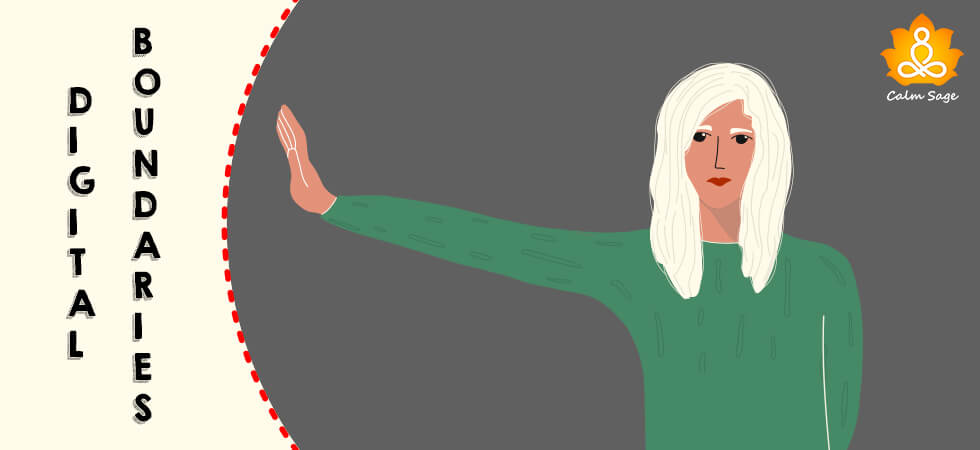Guide Me: How To Set Digital Boundaries For Yourself

There is no denying we are all a little dependent on our smartphones! Interestingly, the relationship with our social media is a love/hate one. Especially, in current times when most of us rely on our digital devices, it is important to maintain a healthy relationship with our time spent digitally, with our digital devices.
The best way to make it work is, setting digital boundaries. To help you with the same we are sharing some effective ways to set digital boundaries in your life with a special section that will help you in your relationships too. Continue reading to find more about digital boundaries.
Digital Boundaries: An Introduction
Digital boundaries are rules that we set for ourselves around our use of technology. It allows you to create a space for yourself from the digital world. Digital boundaries have to do with how you interact with the digital world, such as social media, text, email, and video chats. Through setting digital boundaries you create a healthy mind, body, and relationships.
Need of Digital Boundaries
Katie Lear says that, “Many of us now have devices strapped to our wrists that alert us of new calls, emails, and texts every waking moment. It’s easy to fall into the trap of feeling beholden to answer messages 24 hours a day.” This is not good for your health and well-being.
We feel like we do not have enough time to do all the things that we need to do, but often waste endless hours on our devices. Emails have become a constant source of anxiety, zoom meetings are more common than text messages, and most of us feel that work never ends because we are always connected to work through phones.
This 24/7 access to the digital world is bad. It is bad for our brains, relationships, body, and life. Thus, we need to stop this pattern and set digital boundaries for ourselves.
Ways To Establish Digital Boundaries
Now that we know the meaning of digital boundaries and why it is important for us to practice it, let us learn some ways to create digital boundaries.
A. Limit Your Phone Area and Activities
Start by picking up a pen and paper as we need to make a list first to set digital boundaries. A list of places where your phone will not be allowed. You can even start small and work your way up. Like you can first start separating from your phone at the dinner table on weekends, then slowly progress.
Following this, you have to make another list. In this list you have to define a list of activities that you can do without your digital device around you. Depending on your personal preferences you can create your own list. For example, no phone when studying or cooking.
B. Turn the Notifications Off
BING! BING BING!!! Oh, that is just me, not your phone! I know we are now conditioned to look at our phone every time a notification pops on it, which distracts us, and ruins our focus! Therefore, when talking of digital boundaries these pop-up needs to be set off.
But wait! What if it is an important thing you need to be notified for? Well, here we suggest you to personalise your notification settings such that you are only notified for things that matter, things that need your attention, and are not a source of distraction.
C. Limit Your Check-ins
If I ask you to keep a track every time you look at your phone throughout the day, the tally might surprise you! Some stats suggest that on an average most people check their phones between 98-262 times a day. Which is huge! Which means we nearly check our phones between every 5-20 minutes. This starts interrupting our productivity and ability to concentrate on a given task.
Plus, once you find something interesting you will see yourself glued to your phone for hours! Thus, it calls for setting digital boundaries here. We suggest that you should set your daily screen time and limit your check-ins. The best way to make it happen is by working on a task for 45-50 minutes then check your phone for the next 5-10 minutes.
This will help you in multiple ways. From increased focus to decrease screen time, setting time limits to your check-ins is an important digital boundary for you to set.
D. Optimise Your Social Media
Social media was made to make our lives easier but somehow it has now become a barrier in between our way of achieving mental well-being. Perhaps, it is recommended that our social media should be optimised in a way that it supports our mental health instead of deteriorating it.
Social media on one hand takes up much of our time and it may make us forget about our real-life interests but did you know that with a smart app, you can control your phone usage and prevent social media from ruling your life? Yes! With the Social Fever app, you can smartly and effectively manage your app time by setting timers and staying motivated to stay in touch with your real-life interests.
We have already covered descriptive articles on how to optimize your Instagram and Facebook.
You can check them and set them accordingly.
- How To Optimize Instagram For Your Mental Wellness | Little Secrets For You
- How To Optimize Your Facebook Account For Improved Mental Health
Verbally Setting Digital Boundaries
The strategies of setting digital boundaries suggest above are majorly the actions that you need to take to distance yourself from your devices. However, digital boundaries also need to be expressed to the outside world. We are sharing some digital boundaries examples with you below that will help you understand how to communicate your boundaries to others.
Person 1: Hey, did you send me that email last night?
Communicating your digital boundary:
“Hey, I check my emails when I get into the office. I don’t check office emails out of hours as I feel overwhelmed by it. But don’t worry, I will send it to you as soon as I reach office.”
Person 1: Hey, did you check that post I shared with you on Instagram or Whatsapp group?
Communicating your digital boundary:
“Hey, thank you for sharing it with me but NO, I don’t use my phone on my work desk. I will surely check it during the break time.”
Person 1: I texted you but you didn’t revert. To top it all you were online too.
Communicating your digital boundary:
“Yes, I was online for some office-related work, during which I avoid using my phone for personal means. Next time, you can drop a text and I will revert you as soon as I am available.”
Special Section: Establishing Digital Boundaries In A Relationship
Setting boundaries and respecting them is one of the key elements of healthy relationships. While partners might be maintaining different types of boundaries in a relationship, one must not miss on the digital boundaries. It allows partners to thrive as individuals as well as together. Here are some pointers for you to take care of:
- Consent Before Posting: Ask your partner if it is okay for you to post about your relationship on social media.
- Set Realistic Expectations: You and your partner should not be expected to reply instantly all the time.
- Other Reminders: Even if you completely trust your partner, sharing passwords to your online media is not a good idea.
Setting digital boundaries and communicating whether you feel comfortable within your relationship is necessary and healthy. The earlier you have this conversation the sooner you and your partner can treat each other the way you want to be treated.
P.S. It is ok to unfriend, unfollow, delete, mute or block people on social media. It should be your peaceful space.




















